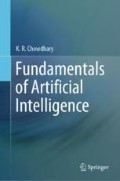Abstract
A machine learning system, in general, learns from the environment, but statistical machine learning programs (systems) learn from the data. This chapter presents techniques for statistical machine learning using Support Vector Machines (SVM) to recognize the patterns and classify them, predicting structured objects using SVM, k-nearest neighbor method for classification, and Naive Bayes classifiers. The artificial neural networks are presented with brief introduction to error-correction rules, Boltzmann learning, Hebbian rule, competitive learning rule, and deep learning. The instance-based learning is treated in details with its algorithm and learning task. The chapter concludes with a summary, and a set of practice exercises.
Access this chapter
Tax calculation will be finalised at checkout
Purchases are for personal use only
References
Aha DW et al (1991) Instance-based learning algorithms. Mach Learn 6:37–66
Boser EB et al (1992) A training algorithm for optimal margin classifiers. In: Proceedings of the fifth annual workshop on computational theory, COLT’ 92. ACM, New York, pp 144–152
Bradley P (2002) Scaling mining algorithms. Commun ACM 45(8):38–43
Clark P, Niblett T (1989) The CN2 induction algorithm. Mach Learn 3:261–283
Cortes C, Vapnik V (1995) Support-vector networks. Mach Learn 20:273–297
Domingos P (2012) A few useful things to know about machine learning. Commun ACM 55(10):78–87
Fukunaga K, Narendra PM (1975) A branch and bound algorithm for computing K-nearest neighbors. IEEE Trans Comput 750–753
Jain AK et al (1996) Artificial neural networks: a tutorial. Computer 3:31–46
Joachims T (2009) Predicting structured objects with support vector machines. Commun ACM 52(11):97–104
Rummelhart DE et al (1994) The basic ideas in neural networks. Commun ACM 37(3):86–92
Shawe-Taylor J (2009) Machine learning for complex predictions. Commun ACM 52(11):96–96
Author information
Authors and Affiliations
Corresponding author
Exercises
Exercises
-
1.
“The task of text categorization is to assign a given document to one of the categories out of a fixed set of categories. This is done on the basis text contents. The Naive Bayes model is often used for this purpose, where a query variable is the document category and the “effect” variables are presence/ absence of each word in the language. It is assumed that words occur independently in the documents, and their frequencies determine the document category.“ For this statement,
-
a.
Explain how such a models can be constructed, given a set of “training data” in the form of documents that have been already assigned to categories.
-
b.
Explain how to categorize a new document.
-
c.
Is the independence assumption reasonable? Justify your answer.
-
a.
-
2.
What linear or nonlinear function is used by an SVM for performing classification? How is an input vector \(\mathbf {x}_i\) (instance) assigned to the positive or negative classes.
-
3.
Consider the SVM for the training data given in \(\mathfrak {R}^2\), in Fig. 14.12a, b; find out the separating hyperplanes in both the cases.
-
4.
Why is the Naive Bayes classification called Naive? What are the main goals behind this classification?
-
5.
Consider the data given in Table 14.1, and use these to train a Naive Bayes classifier with designation attribute as the class label and all the remaining attributes regarded as input. Once you have your Naive Bayesian classifier, test the following unseen instances to find out the class:
-
a.
Marketing, \(36\ldots 41\), \(51K \ldots 55K\)
-
b.
Sale, \(36\ldots 41\), \(71K \ldots 75K\)
-
a.
Rights and permissions
Copyright information
© 2020 Springer Nature India Private Limited
About this chapter
Cite this chapter
Chowdhary, K.R. (2020). Statistical Learning Theory. In: Fundamentals of Artificial Intelligence. Springer, New Delhi. https://doi.org/10.1007/978-81-322-3972-7_14
Download citation
DOI: https://doi.org/10.1007/978-81-322-3972-7_14
Published:
Publisher Name: Springer, New Delhi
Print ISBN: 978-81-322-3970-3
Online ISBN: 978-81-322-3972-7
eBook Packages: Computer ScienceComputer Science (R0)


